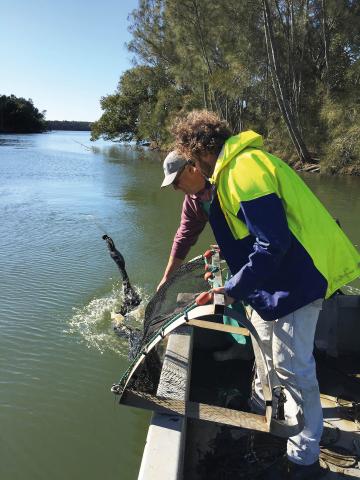Saltmarshes receive new recognition for their crucial role in the food chain and the economic productivity of coastal fisheries
By Aisling Fontanini

Researchers use a sampling sled to capture prawns in NSW estuaries in order to identify the most valuable habitat.
Photo: NSW Department of Primary Industries
Geoff Hyde has been commercially fishing prawns in the New South Wales Hunter River region for almost 70 years and boasts of being able to buy his first car in cash after a good day’s fishing on the river. “The amount of prawns in those days was incredible,” he says.
But he saw prawn numbers begin to decline after tidal floodgates were installed on Hexham Swamp in the 1970s to provide more freshwater and grazing land for livestock. As a result, he has been a long-time advocate for the return of saltwater tidal flows to the swamp to restore its role as part of prawn nursery grounds.
In 2013, land managers completed works to re-open floodgates and reconnect the tidal flows from the lower estuary to the Hexham wetland. This research found a high number of prawns in the reconnected area, a finding Geoff Hyde says speaks for itself.
He is one of several commercial fishers who have assisted researchers involved in a four-year FRDC-funded research project to unravel how land management practices have changed the dynamics of wetlands and the fisheries that rely on them, particularly the Eastern King Prawn (Melicertus plebejus) fishery.
And although recently retired, he has welcomed the research findings that show estuarine habitats – and saltmarsh in particular – are a crucial part of the fisheries food chain and a major contributor to the region’s economy.
Matt Taylor from NSW Department of Primary Industries led the multidisciplinary project team that included researchers from the University of Newcastle, Griffith University, and the University of New South Wales.
Their aim was to unravel the complicated relationships between fishery productivity and estuarine habitats in three NSW estuaries: the Clarence River north of Coffs Harbour, and the Hunter River and to a lesser extent Lake Macquarie, both near Newcastle. They wanted to establish the potential impact of habitat repair on the Eastern King Prawn and other important estuarine species.
Role of estuaries
Available aerial imagery documents a 74 per cent loss of saltmarsh habitats in the Hunter River from the 1950s to the 1990s. In the Clarence River, 64 per cent of saltmarsh has been lost, as has 79 per cent of seagrass cover, since the 1940s.
While seagrass is regularly touted as an important source of food and nursery habitat, Matt Taylor says this research shows “it’s not all about seagrass”.
“There are really strong links between saltmarshes (and to a lesser extent mangroves) and the broader estuarine ecosystem where most of the fishing takes place. In seagrass-limited systems such as the Hunter and Clarence Rivers, saltmarsh is particularly important for supporting prawn populations,” he says.
Eastern King Prawn
The research focused initially on Eastern King Prawn as a commercially important species that is fast growing, abundant, and reproduces quickly.
The 2015-16 annual catch in NSW was more than 500 tonnes, and in Queensland 2300 tonnes, with a combined value of about $40 million.
“It is NSW’s most valuable prawn fishery,” says Matt Taylor. “The prawns are a tasty, high-quality product, and fetch a high price.”
And NSW estuaries provide important nursery grounds for Eastern King Prawns, he says.
While adult prawns actually reproduce in northern NSW and Queensland waters, the larvae then ride south on the East Australian Current, seeking estuaries such as those in the Hunter and Clarence Rivers and Lake Macquarie. Entering their post-larval phase, the prawns settle into these estuaries where they grow to adults, before heading to sea, and northwards to reproduce.
In an effort to understand how prawns and other commercial species were interacting with estuarine habitats, Matt Taylor’s team combined extensive field sampling, laboratory experiments, and numerical modelling. The results provided some unexpected findings.

These Eastern King Prawns captured at Ballina, NSW, will have grown to adulthood in more southern estuaries.
Photo: NSW Department of Primary Industries
Saltmarsh scrubs (Sporobolus virginicus and other species) become submerged during spring tides for up to six hours a day and stretch more than 760 hectares in the Hunter River and 280 hectares in the Clarence River. The tidal flooding of these vast saltmarsh areas creates opportunities for estuary animals to leave the adjacent channels and come up onto the marsh surface.
Matt Taylor says it was a surprise that Eastern King Prawn and Eastern School Prawn (Metapenaeus macleayi) were not found directly in these inundated saltmarsh habitats, unlike similar species in other parts of the world. In fact, from the many thousands of animals caught in fyke nets over the saltmarsh surface, only eight were Eastern King Prawn.
He says this shows there isn’t a strong direct interaction between the prawns and the marsh surface, although he did find high densities of prawns within the subtidal marsh channels.
Saltmarsh diet
Matt Taylor says the importance of saltmarsh to fisheries in the Clarence and Hunter River estuaries seems to lie in an indirect trophic relationship. Isotopic analysis showed that saltmarsh is the dominant source of prawn nutrition in these two estuaries. It was responsible for as much as 95 per cent of the diet in commercially fished prawns in the Clarence and 47 per cent in the Hunter.
“There are animals that are feeding on the saltmarsh grass, but the saltmarsh grass, like a lawn, grows and dies. The animals that feed directly on the grass, and the detritus derived from the saltmarsh, are being washed through the system to support the food web in the broader estuary,” Matt Taylor says.
Saltmarsh was also a significant nutritive habitat in both estuaries for a range of commercially fished species such as Mulloway (Argyrosomus japonicas), Dusky Flathead (Platycephalus fuscus), and Sea Mullet (Mugil cephalus). Recent work by the University of Newcastle has also confirmed this pattern in other NSW estuaries where seagrass is much more abundant than it is in the Clarence and Hunter River estuaries.
Strategic restoration
Researchers used stable isotopes, chemical signatures that are accumulated in the bodies of the prawns as juveniles, as tracers to identify important nursery areas. By catching prawns as they emigrated through the mouth of the estuary and comparing them with the chemical signatures found in prawns captured throughout the estuary, researchers were able to deduce which areas emigrating prawns were most likely to have come from.

Matt Taylor, NSW Dept Primary Industries
Quantitative sampling found some of the highest Eastern King Prawn densities in the lower part of the rehabilitated Hexham Swamp. This has gone a long way to vindicate Geoff Hyde’s advocacy for the restoration of tidal flows to wetlands in the Hunter River system. The isotope analysis has also helped to predict which areas in the Hunter and Clarence River estuaries are likely to have the most positive impact on prawn productivity if habitat restoration is undertaken.
As part of this project, results were combined with other fisheries data sources, which allowed the research team, for the first time, to estimate an economic value derived from these saltmarsh and mangrove habitats through the fisheries harvest they support.
Economic value
“This really does allow economic comparisons between the different uses you can have for reclaimed saltmarsh, which is essential for mounting an economic case for habitat repair,” Matt Taylor says.
The model used data from several important commercial fisheries in the study, including Yellowfin Bream (Acanthopagrus australis), Mulloway, Dusky Flathead, Luderick (Girella tricuspidata), Sea Mullet, Giant Mud Crab (Scylla serrata), Blue Swimmer Crab (Portunus armatus) and Eastern School Prawn.
For each species, the model considers the proportion of exploited biomass that is attributed to nutrition from saltmarsh and mangrove habitats. For example, Mud Crab in the Hunter River estuary derive 46 per cent of their nutrition from saltmarsh grass, and 24 per cent from mangroves. By applying historical catch and market value data, incorporating uncertainty, and making a few simple assumptions, the model estimates the potential economic value of the fisheries harvest that may be supported by different estuarine habitats.
It found that, each year, saltmarsh habitats on average support $7.2 million of revenue in the Clarence River and $1.3 million in the Hunter River through the extraction and commercial sale of the fish and crustaceans listed above.
Mangrove habitats account for $3.5 million and $600,000 of income in the Clarence and Hunter estuaries, respectively.
“These are probably conservative estimates, because they do not account for the value of recreationally harvested biomass that is also supported by these habitats,” Matt Taylor says.
The research findings are already being used to plan future habitat repair in NSW, including prioritising areas for restoration and mounting a supporting business case. The approach developed by this project is also being incorporated in another FRDC-funded project, 2017-175, as part of a large program to develop a Natural Capital Accounting framework for Australia, being led by CSIRO.
FRDC Research Code: 2013-006





